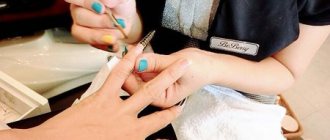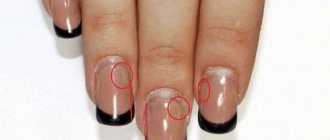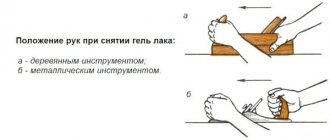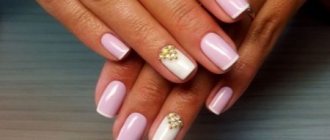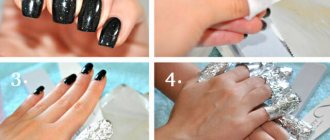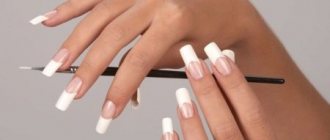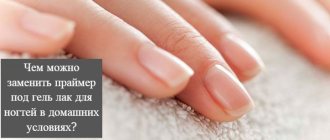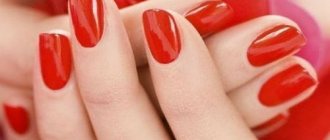How long will gel polish last? The gel coating looks impressive and does not react to environmental influences.
Due to the fear of a short-term effect, many women are interested in how long gel polish lasts and how to extend its wearing period? The condition of the nail plates, the quality of the material and application conditions affect how long the gel polish will last on your hands. It contains special substances that can ensure strong adhesion of the nail to the coating. How long a gel polish manicure will last depends on following the correct layering technology.
Harm of gel nail polish
The creation of gel polish at one time created a real sensation. Of course, women’s lives in terms of manicure have become much easier. At least in some segment of the beauty industry, beauty has ceased to require sacrifice. There is no need to paint your nails every day. Gel polish lasts for three weeks. You can also say goodbye to chipped nails. Beauty, variety of decor, convenience and durability. This is how gel polish won the love of women.
But experts do not recommend overusing even regular polish, let alone gel polish. Constantly wearing such a colored layer harms the nail plate, interferes with air exchange, and violates the nail’s own protective layer.
Some manicurists boast of their ability to apply gel polish under the cuticle. Why is this so valuable? Yes, because this way the manicure looks neat longer. The regrown part of the nail is not visible. This service is also called deep manicure. But it is not at all useful either for nails or for us. The fact is that with such manipulation the root of the nail is damaged. In the professional sphere, this place is called the matrix. As a result, longitudinal grooves may appear on the nails. Cracks may even appear at the base of the nail. You understand that such a defect will take a long time to grow.
Go ahead. We need the cuticle in order to protect the matrix from external influences. From dirt, infections, aggressive household chemicals and various mechanical damage. When a cuticle master pushes back, he, firstly, damages it. Secondly, all the unhealthy substances contained in the varnish are much more likely to enter your body. This procedure can damage the nail folds and cause inflammation.
Each gel polish has its own wear time. And the manufacturer must indicate it on the packaging. If, of course, he is conscientious and cares about his consumers. You don’t need to remove polish when your nails have grown long and started to look sloppy. And then, when the manufacturer indicated. Because after this period the polymer bonds in shellac disintegrate. Then such a manicure is not only unwearable, it is dangerous to health. When the polymer bonds of the varnish are destroyed, harmful components are released and enter our body. The result may be allergies or even bronchial asthma. Further, if you rewear the gel polish on your nails, the adhesion between the nail and the polish becomes stronger. It will be more difficult to remove. In this regard, the risk of nail damage increases.
Why determine the stress zone of the nail?
When you go to a beauty salon to treat yourself to a new manicure, they apply a coating that starts at the cuticle. The master levels the nail plate with a rubber base and makes a thick enough layer of material so that it holds well and does not chip off. The stress zone at this moment is closer to the cuticle and practically serves as the basis of the coating. This allows you not to worry about cracks for the next couple of weeks at least.
But do not forget that nails gradually grow back. This means that the stress zone also shifts in the direction of plate growth and ceases to be the “framework” of the coating. That is why it is recommended to change the manicure in a timely manner so as not to break the regrown length at the root.
So, how many weeks can you wear gel polish? Experienced professionals recommend changing the coating every 3 weeks. This time will be enough to admire the chosen color and design without harming your nails.
How to determine your stress zone
If you don’t know how to independently determine where your stress zone is, then you should do the following:
1. Remove all material from nails.
2. Lightly press on the free edge. The top part should turn white.
3. The point where the border between white and pink is located is a stress zone. This is where the greatest thickness of the material should be. Approximately up to this limit, you can safely wear grown-out gel polish, then it’s worth changing it.
Dangers to nails
The procedure for applying gel polish can adversely affect your health.
Effect of varnish
According to experts, daily painting with even ordinary varnish is extremely harmful. Prolonged wearing of the gel causes irreparable damage to the nail plate, since the coating prevents the penetration of oxygen . In addition to this, the nail is left without a top protective layer. Long-term wearing or use of a low-quality product can lead to negative consequences for the nail plate. It could be:
- yellow tint;
- uneven and bumpy surface;
- delamination;
- dull color;
- thinning;
- formation of cracks.
Drying in a UV lamp
Experts note the negative impact of UV lamps on human health when covering nails with a cosmetic product. However, due to the small amount of time the lamp is used, its negative effect is minimized.
Important! The exception is direct contraindications to the use of ultraviolet radiation, for example, cancer. In such cases, decorative coating using the device should be categorically abandoned.
Removing old coating
Removing gel polish with acetone has a negative effect on your nails. The product dries the skin and disrupts the nail structure . Constant inhalation of acetone vapor causes problems with the nervous system. Because of this harmful effect, craftsmen prefer to cut off the old gel with a special cutter.
Removing a manicure yourself can lead to injury to the nail plates.
Harm from gel polish: signs
There are some clear indicators that gel polish is harming you. They are visible to the naked eye:
- yellowing of one or more nails;
- the appearance of irregularities and bumps
- splitting of nails;
- dullness of the nail plate;
- thinning of the nail;
- the appearance of brittleness and cracks.
If you notice one, and even more so several, such signs in yourself, then you should at least wait a while with gel polish. It’s better to give it up completely. Because in addition to such cosmetic disadvantages, gel polish carries much more serious harm to the health of the entire body. More on this below.

About the growth rate of fingernails
In an adult healthy person, the nail plate is renewed on average in 2-4 months (depending on who it is). Nails on the left and right hands grow at different rates. If you are right-handed, your nails will grow faster on your right hand. If you are left-handed, then vice versa. Even on the same hand, the rate of nail growth on different fingers will be different. So nails grow fastest on the middle fingers, and slower on the big and little fingers. These differences are so small that visually we do not notice them. But we most often get chips and cracks on those hands and on those fingers where nails grow fastest
Is it possible to do shellac while pregnant?
It is not prohibited to apply gel polish to your nails during pregnancy. To protect yourself and your unborn baby, you need to listen to the advice of experts. If the recommendations are followed, the procedure will not cause any harm, but the following is required:
- Before coating, apply nourishing cream to your hands;
- make sure there is access to fresh air in the cabin;
- the manicure chair should be as comfortable as possible;
- Use only high-quality gel polish. A product that is dangerous to use can be identified by an unpleasant aroma and a bottle that does not have a label . The bottle must be numbered. If there is no license plate at the bottom of the bottle, it is better to refuse the procedure;
- do not get manicures from specialists who receive clients at home. You may have to deal with improper handling of instruments.
Simple steps for good results
Are you worried why shellac (gel polish) doesn't last? Follow the simple recommendations described above, listen to the advice of a professional technician, and if you do the coating yourself, then do not neglect the stages of the technology. Using fairly simple methods, you can significantly extend the life of your manicure, so you don’t have to worry about how long gel polish lasts. Reviews from professionals about certain brands and coating application methods are also worth carefully studying, because the opinions of experienced craftsmen are often very useful.
Composition of gel polish
The apparent advantages of varnish hide its main disadvantages and dangers. For shine, strength, smooth application and long-lasting wear of shellac, various chemicals are added to it. And the main harm of gel polish lies in its composition. Do not think that if the nail is hard, then it does not absorb anything and nothing gets into the body. This is a misconception. Everything is absorbed through the nail plate in the same way as through the skin.
So, gel polishes contain such harmful ingredients as:
| Ingredient | Harm |
| Toulol | a solvent used in paints and varnishes. And the fact that it is included in nail polishes and paints for various surfaces should already alert you... It is toxic if inhaled. It can cause problems with the kidneys, liver and bile ducts, and damage muscles. Irritates eyes, causing redness and dryness. Toulol vapor may adversely affect fetal development in pregnant women |
| Formaldehyde | Let's start with the fact that it is poison. And it's toxic. Harms the immune system, liver and can cause cancer. Contact with formaldehyde is strictly prohibited for pregnant women and asthmatics. It accumulates under the nails, dries them out and thins them. And phenol-formaldehyde resin can cause inflammatory skin lesions, allergies, and respiratory diseases |
| Triphenylphosphate | destroys the human endocrine system and proper metabolism. Harmful to the environment. Included in the list of prohibited ingredients |
| Dibutyl phthalate | adds plasticity to the varnish and makes the color more stable. Toxic. In general, all phthalates negatively affect the functioning of the thyroid gland and endocrine system. Harmful to skin and lungs |
| Waxy antioxidant butylated hydroxyanisole | harms the hormonal system |
| Ethyl tosylamide | has a medium hazard class, toxic. Harmful if inhaled |
| Butyl acetate, ethyl acetate | are used as solvents. Irritates mucous membranes of the throat and eyes. Prolonged inhalation of these vapors causes rapid breathing and decreased physical activity. Harmful to the central nervous system |
| Nitrocellulose | The base of the varnish serves to form a hard and even film on the nails. Also irritating to the respiratory system, toxic |
| Styrene copolymer acrylate | added to nail polish to form a waterproof film on nails. Harmful if inhaled. Irritating to skin and eyes. Not safe for the environment |
| N-butyl alcohol | may cause headaches, eye and respiratory tract irritation |
| Propylene glycol | preservative, causes skin irritation, can damage the functioning of the kidneys and liver. May cause cancer |
These are not all the harmful components of shellac; in fact, there are many more of them. The main thing is that they are all toxic and dangerous when inhaled, even in small doses. Well, if you breathe all this once every three weeks for several hours, then you are guaranteed to have health problems.
Want to know which polishes and gel polishes are safe to use? We conducted an expert assessment of more than 20 varnishes, identifying both safe products and products with critical ingredients. You can see some of these funds in the picture above. To find out more, go to ecoface.ru in the ECOTESTS section. Select the “Body” category and check the box next to the eco-test you need. Just 5 minutes and you get a ready-made table with ratings of manicure products for only 150 rubles.
Go to ecoface.ru
Harm from manicure
Of course, the harm is not the finished manicure itself, but the manipulations that are used in the process of creating it. Not only gel polish can cause harm, but also an incorrectly and illiterately done manicure.
If the master does not follow the technique during the manicure procedure, he can damage the nerves located near the nail. Damage to the cuticle and resulting microtraumas are especially dangerous. The varnish applied to the nail penetrates them and enters the body through the blood vessels. Of course it's dangerous.
Among other things, there is a high risk of getting an infection. Nail technicians are not dermatologists, they do not understand fungi. They give manicures to everyone, without paying much attention to the condition of the client’s nails. And then they use the same tools to work with the next and next client. And it’s good if the master is responsible and disinfects the tools after each procedure. If not, then the fungus from the nails of the previous client will quite easily migrate to your nails.
And the lamp under which you dry your nails is also harmful. It provokes the appearance of skin cancer. A US publication called Archives of Dermatology conducted an interesting study in 2009. It concluded that systematic irradiation of the skin, even for 10 minutes, greatly increases the risk of skin cancer. And in 2012, the British Journal of Dermatology published information stating that several women developed cancer precisely because of manicure drying lamps.
How to reduce harmful effects?
The use of high-quality materials guarantees minimal harm. To avoid any negative consequences of manicure, you should follow certain recommendations:
- it is necessary to strictly adhere to the coating technology, without deviating from the existing rules of the procedure;
- pause after three or four applications of the cosmetic product. During the break, it is advisable to undergo a course of therapeutic coatings and paraffin therapy . If your nails become very peeling, you can carry out procedures with fruit acids. Homemade baths and hand masks will consolidate the results;
- Do not manicure on sick or peeling nails. This is especially true for plates affected by fungus. As we have already written, they need to be completely cured before the procedure ;
- if the skin around the nail is too sensitive or cracked, it is prohibited to use decorative coatings until the damaged areas are restored;
- It is necessary to regularly rub medicinal oils into the cuticle area.
Vitamins for strengthening nails, dosage regimen
I made a regimen for taking vitamin complexes to strengthen my nails. The course of treatment is 2-3 months.
- Biotin Solgar Solgar, Biotin, 1000 mcg (drink 2 capsules per day) or
- Complex for hair and strengthening nails Country Life, Maxi-Hair, 90 Tablets (drink 2 tablets per day)
- Orthosilicic acid for nails and hair Natural Factors, BioSil, ch-OSA Advanced Collagen Generator (drink 2 capsules per day)
- Omega acids to restore nails are needed from Natural Factors, WomenSense, RxOmega-3, Women's Blend (drink 2 capsules per day)
That makes just three nail supplements that will also improve hair and skin: biotin, orthosilicic acid, and omega acids.

